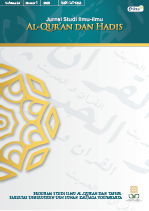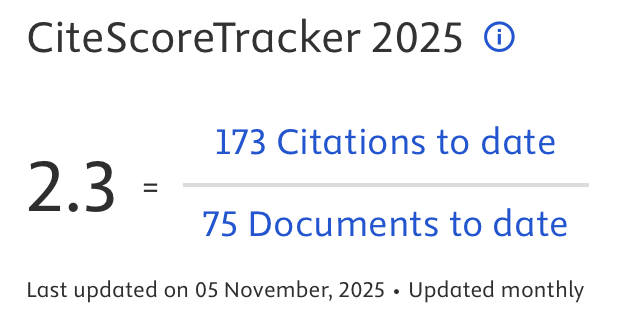Intertextuality and Late Antiquity in Michael E. Pregill's Interpretation of the Worship of the Golden Calf in Surah Thāhā: 83-97
DOI:
https://doi.org/10.14421/qh.v24i1.4093Keywords:
Late Antiquity Era, Intertextuality, Michael E. Pregill, Qs. Thāhā: 83-97, The Worship of the Golden CalfAbstract
Michael E. Pregill argues that the story in Surah Thāhā: 83-97 reflects an interpretation trend of a story in the Bible, thriving among Jews and Christians in Late Antiquity, about Israelites who worshipped the golden calf. Pergill also argues about the intertextuality between the Qur’an and Bible. This study aims to comprehensively examine Pregill’s interpretation of Surah Thāhā: 83-97 as it responds to the differences in detailed stories of golden calf worship in the Qur’an and Bible and various interpretations of Al-Sāmīrī. Primary data of this qualitative study included a book entitled The Golden Calf between Bible and Qur’an: Scripture, Polemic, and Exegesis from Late Antiquity to Islam. Relevant data were collected and analyzed through data condensation, data display, and conclusion drawing/verification. According to Pregill, Al-Sāmīrī was a literary work of the Qur’an using biblical materials; then, Qur’an applied it to Harun’s name and emphasized his role as the Israelites’ guardian. The intertextuality between Qur’an and Bible was perceived from the possibility of using Ethiopic Bible materials to retell the event. In response to interpretation trends focusing on covenant, priesthood, and idolatry themes, Pregill argues that the Qur’an has affirmed Harun’s position as the Priest under Moses the Prophet.
 Abstract viewed: 682 times
|
Abstract viewed: 682 times
|
 PDF downloaded = 545 times
PDF downloaded = 545 times
References
Albayrak, Ismail. “The Qur’anic Narratives of the Golden Calf Episode.” Journal of Qur’anic Studies 3, no. 1 (2001).
Allen, Graham. Intertextuality. New York: Routledge, 2006.
Altinel, Tolga Savaş. “An Evaluation of the Identity of Sāmirī in the Qur’ān.” Ilahiyat Studies 9, no. 1 (2018).
Amzallag, Nissim. “Beyond Idolatry – The Transgression of the Golden Calf Revisited.” Old Testament Essays 33, no. 2 (2020).
Assefa, Daniel, and Kelley Coblentz Bautch. “Did the Sheep Worship the Golden Calf? The Animal Apocalypse’s Reading of Exodus 32.” In Golden Calf Traditions in Early Judaism, Christianity, and Islam, edited by Eric F. Mason and Edmondo F. Lupieri, 59–72. Leiden dan Boston: Brill, 2019.
Bautch, Richard J. “The Golden Calf in the Historical Recitals of Nehemiah 9 and Psalm 106.” In Golden Calf Traditions in Early Judaism, Christianity, and Islam, edited by Eric F. Mason and Edmondo F. Lupieri, 49–58. Leiden dan Boston: Brill, 2019.
Briceño, Tarcicio Gaitán, Emigdio Mendoza Fandiño, and Piedad Gañán Rojo. “The Destruction of the Golden Calf (Ex 32:20): A Materials Science Perspective.” Verbum et Ecclesia 42, no. 1 (2021).
Chung, Youn Ho. The Sin of the Calf: The Rise of the Bible’s Negative Attitude Toward the Golden Calf. New York dan London: Bloomsbury T&T Clark, 2010.
Clark, Gillian. Late Antiquity: A Very Short Introduction. Oxford: Oxford University Press, 2011.
Cole, Juan. “Paradosis and Monotheism: A Late Antique Approach to the Meaning of Islām in the Quran.” Bulletin of the School of Oriental and African Studies 82, no. 3 (2019).
Darmawan, Dadang. “ANALISA KISAH YUSUF DALAM ALQURAN DENGAN PENDEKATAN HERMENEUTIKA.” Al-Bayan: Jurnal Studi Ilmu Al- Qur’an dan Tafsir 1, no. 1 (2016): 8–16.
Denissa, Lois, Yasraf Amir Pialang, Pribadi Widodo, and Damayanti Nuning Yanti Adidsasmito. “Fenomena Intertekstualitas Fashion Karnaval Di Nusantara.” Panggung 26, no. 4 (2016).
El-Badawi, Emran Iqbal. The Qur’ān and the Aramaic Gospel Traditions. London dan New York: Routledge, 2014.
Haleem, M. A.S.Abdel. “The Qur’anic Employment of the Story of Noah.” Journal of Qur’anic Studies 8, no. 1 (2008): 38–57. Accessed July 4, 2022. https://www.euppublishing.com/doi/10.3366/jqs.2006.8.1.38.
Hayes, Andrew J. “The Incident of the Golden Calf in Pre-Islamic Syriac Authors.” In Golden Calf Traditions in Early Judaism, Christianity, and Islam, edited by Eric F. Mason and Edmondo F. Lupieri, 238–263. Leiden dan Boston: Brill, 2019.
Hidayat, Wildan. “Representasi Makna Ideologis Kisah Aṣḥâb Al-Kahf: Analisis Semiotika Roland Barthes Dalam Surah Al-Kahf.” Mutawatir 8, no. 1 (2020).
Johns, A. H. “Shuʿayb, Orator of the Prophets: Reflections on Qur’anic Narrative.” Journal of Qur’anic Studies 13, no. 2 (2011): 136–148. Accessed July 4, 2022. https://www.euppublishing.com/doi/10.3366/jqs.2011.0025.
Kerry-Moran, Kelli Jo, and Juli-Anna Aerila. “Introduction: The Strength of Stories.” In Story in Children’s Lives: Contributions of the Narrative Mode to Early Childhood Development, Literacy, and Learning. Switzerland: Springer Nature Switzerland AG, 2019.
Khafidhoh, Khafidhoh. “Penafsiran Intertekstualitas: Telaah Konsep Hermeneutika Komaruddin Hidayat.” Al-Adabiya: Jurnal Kebudayaan dan Keagamaan 14, no. 01 (2019): 103–117.
Khalafallah, Muhammad Ahmad. Al-Qur`an Bukan “Kitab Sejarah”: Seni, Sastra Dan Moralitas Dalam Kisah-Kisah Al-Qur`an. Translated by Zuhairi Misrawi and Anis Maftukhin. Jakarta: Paramadina, 2002.
Lowin, Shari L. The Making of a Forefather: Abraham in Islamic and Jewish Exegetical Narratives. Leiden dan Boston: Brill, 2006.
Miles, Matthew B., A. Michael Huberman, and Johnny Saldana. Qualitative Data Analysis: A Methods Sourcebook. 3rd ed. USA: SAGE Publications Inc., 2014.
Mushodiq, Muhamad Agus, Ibnu Burdah, Suja’i Suja’i, Mispani Mispani, and Habib Shulton Asnawi. “Urgensi Zoologi Sastra Alquran: Studi Kasus Pada Seni Kisah Zoomorfik Al-Farasy Surat Al-Qari’ah.” AL QUDS : Jurnal Studi Alquran dan Hadis 5, no. 1 (2021): 1.
Nadia, Zunly. “Telaah Struktural Hermeneutik Kisah Nabi Ibrahim Dalam Alquran.” Mutawatir : Jurnal Keilmuan Tafsir Hadith 10, no. 1 (2020): 117–143. Accessed July 6, 2022. http://jurnalfuf.uinsby.ac.id/index.php/mutawatir/article/view/1225.
Netton, Ian Richard. “Towards a Modern Tafsīr of Sūrat Al-Kahf: Structure and Semiotics.” Journal of Qur’anic Studies 2, no. 1 (2010): 67–87. Accessed July 7, 2022. https://www.euppublishing.com/doi/10.3366/jqs.2000.2.1.67.
Neuwirth, Angelika. “Locating the Qurʾan and Early Islam in the ‘Epistemic Space’ of Late Antiquity.” In Islam and Its Past: Jahiliyya, Late Antiquity, and the Qurʾan. United Kingdom: Oxford University Press, 2017.
———. “The ‘Discovery of Writing’ in The Qur’an: Tracing An Epistemic Revolution in Late Antiquity.” Nun : Jurnal Studi Alquran dan Tafsir di Nusantara 2, no. 1 (2016). Accessed July 7, 2022. https://ejournal.aiat.or.id/index.php/nun/article/view/2.
———. “Two Faces of the Qur’ān: Qur’ān and Muṣḥaf.” Oral Tradition 25, no. 1 (2010).
Ozgur Alhassen, Leyla. Qur’ānic Stories: God, Revelation and the Audience. Edinburgh: Edinburgh University Press, 2021.
Palombo, Cecilia. “Formulae and Repetition in the Medinan Qur’an: The Story of the Golden Calf between Meccan and Medinan Suras.” In Unlocking the Medinan Qur’an, edited by Nicolai Sinai, 19:120–163. Brill, 2022.
Pregill, Michael E. The Golden Calf between Bible and Qur`an: Scripture, Polemic, and Exegesis from Late Antiquity to Islam. Oxford: Oxford University Press, 2020.
Rahmatullah, Rahmatullah. “HERMENEUTIKA INTERTEKSTUALITAS MUQÂTIL BIN SULAYMÂN.” Jurnal Studi Ilmu-ilmu Al-Qur’an dan Hadis 20, no. 2 (2019): 126–142.
Ramos-Gay, Ignacio. “Animality and Biblical Masculinities in Conflict: Moses and the Golden Calf (Exodus 32).” Men and Masculinities 23, no. 5 (2020).
Reynolds, Gabriel Said. The Qur`an and the Bible. New Haven dan London: Yale University Press, 2018.
Smith, Andrew C. “Moses and Pharaoh’s Magicians: A Discursive Analysis of the Qur’anic Narratives in the Light of Late Antique Texts and Traditions.” Journal of Qur’anic Studies 20, no. 1 (2018): 67–104. Accessed July 4, 2022. https://www.euppublishing.com/doi/10.3366/jqs.2018.0321.
Tobin SJ, Thomas H. “Philo of Alexandria’s Interpretations of the Episode of the Golden Calf.” In Golden Calf Traditions in Early Judaism, Christianity, and Islam, edited by Eric F. Mason and Edmondo F. Lupieri, 73–86. Brill, 2019.
Di Vito, Robert A. “The Calf Episodes in Exodus and Deuteronomy: A Study in Inner-Biblical Interpretation.” In Golden Calf Traditions in Early Judaism, Christianity, and Islam, edited by Eric F. Mason and Edmondo F. Lupieri, 1–25. Leiden dan Boston: Brill, 2019.
Watts, James W. “Aaron and the Golden Calf in the Rhetoric of the Pentateuch.” Journal of Biblical Literature 130, no. 3 (January 1, 2011): 417–430. Accessed July 4, 2022. https://scholarlypublishingcollective.org/sblpress/jbl/article/130/3/417/179427/Aaron-and-the-Golden-Calf-in-the-Rhetoric-of-the.
WS, Hasanuddin. Transformasi Budaya Dan Produksi Sosial Teks: Kajian Intertekstualitas Teks Cerita Anggun Nan Tungga Magek Jabang. Bandung: ANGKASA, 2017.
Yanti, Ziska. “Kajian Intertekstualitas Ayat Ahl Al-Kitab Dalam Tafsir Al-Misbah Karya Quraish Shihab Dengan Tafsir Al-Mizan Karya Husein Thabathaba’i.” El-Maqra` Jurnal Ilmu Al-Qur`an, Hadis dan Teologi 2, no. 1 (2022). Accessed July 4, 2022. https://ejournal.iainkendari.ac.id/index.php/el-maqra/article/view/3988.
Downloads
Published
How to Cite
Issue
Section
License
Copyright (c) 2023 Nur Afra Afifah Amani Amatullah, Nur Laili Nabilah Nazahah Najiyah, Inayah Rohmaniyah

This work is licensed under a Creative Commons Attribution-NonCommercial-NoDerivatives 4.0 International License.
Publishing your paper with Jurnal Studi Ilmu-ilmu al-Qur'an dan Hadis means that the author or authors retain the copyright in the paper. Jurnal Studi Ilmu-ilmu al-Qur'an dan Hadis uses license CC-BY-NC-ND or an equivalent license as the optimal license for the publication, distribution, use, and reuse of scholarly works. This license permits anyone to copy and redistribute the material in any medium or format and must give appropriate credit, provide a link to the license, and indicate if changes were made. If you remix, translate, transform or build upon the material you may use it for private use only and not for distribution. Jurnal Studi Ilmu-ilmu al-Qur'an dan Hadis granted an exclusive non-commercial reuse license by the author(s), but the author(s) are able to put the paper onto a website, distribute it to colleagues, give it to students, use it in your thesis, etc, so long as the use is not directed at a commercial advantage or toward private monetary gain. The author(s) can reuse the figures and tables and other information contained in their paper published by Jurnal Studi Ilmu-ilmu al-Qur'an dan Hadis in future papers or work without having to ask anyone for permission, provided that the figures, tables, or other information that is included in the new paper or work properly references the published paper as the source of the figures, tables or other information, and the new paper or work is not direct at a private monetary gain or commercial advantage.
Jurnal Studi Ilmu-ilmu al-Qur'an dan Hadis journal Open Acces articles are distrubuted under the Creative Commons Attribution-NonCommercial-NoDerivatives 4.0 International (CC BY-NC-ND 4.0). Article can be read, copy and redistribute the material ini any medium or format under the following conditions:
Attribution — You must give appropriate credit, provide a link to the license, and indicate if changes were made. You may do so in any reasonable manner, but not in any way that suggests the licensor endorses you or your use.
NonCommercial — You may not use the material for commercial purposes.
NoDerivatives — If you remix, transform, or build upon the material, you may not distribute the modified material.










